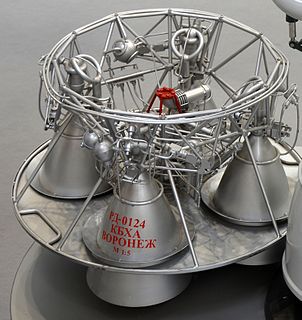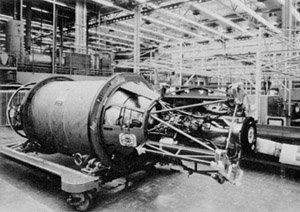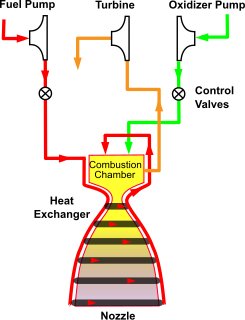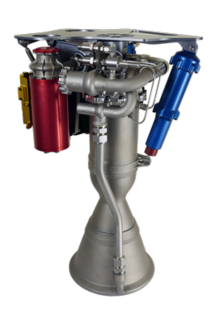
A turbopump is a propellant pump with two main components: a rotodynamic pump and a driving gas turbine, usually both mounted on the same shaft, or sometimes geared together. The purpose of a turbopump is to produce a high-pressure fluid for feeding a combustion chamber or other use.
A propellant is a mass that is expelled or expanded in such a way as to create a thrust or other motive force in accordance with Newton's third law of motion, and "propel" a vehicle, projectile, or fluid payload. In vehicles, the engine that expels the propellant is called a reaction engine. Although technically a propellant is the reaction mass used to create thrust, the term "propellant" is often used to describe a substance which is contains both the reaction mass and the fuel that holds the energy used to accelerate the reaction mass. For example, the term "propellant" is often used in chemical rocket design to describe a combined fuel/propellant, although the propellants should not be confused with the fuel that is used by an engine to produce the energy that expels the propellant. Even though the byproducts of substances used as fuel are also often used as a reaction mass to create the thrust, such as with a chemical rocket engine, propellant and fuel are two distinct concepts.

The expander cycle is a power cycle of a bipropellant rocket engine. In this cycle, the fuel is used to cool the engine's combustion chamber, picking up heat and changing phase. The now heated and gaseous fuel then powers the turbine that drives the engine's fuel and oxidizer pumps before being injected into the combustion chamber and burned.

A liquid-propellant rocket or liquid rocket utilizes a rocket engine that uses liquid propellants. Liquids are desirable because they have a reasonably high density and high specific impulse (Isp). This allows the volume of the propellant tanks to be relatively low. It is also possible to use lightweight centrifugal turbopumps to pump the rocket propellant from the tanks into the combustion chamber, which means that the propellants can be kept under low pressure. This permits the use of low-mass propellant tanks that do not need to resist the high pressures needed to store significant amounts of gasses, resulting in a low mass ratio for the rocket.

The Aerojet Rocketdyne RS-25, also known as the Space Shuttle Main Engine (SSME), is a liquid-fuel cryogenic rocket engine that was used on NASA's Space Shuttle. NASA is planning to continue using the RS-25 on the Space Shuttle's successor, the Space Launch System (SLS).

The J-2 is a liquid-fuel cryogenic rocket engine used on NASA's Saturn IB and Saturn V launch vehicles. Built in the U.S. by Rocketdyne, the J-2 burned cryogenic liquid hydrogen (LH2) and liquid oxygen (LOX) propellants, with each engine producing 1,033.1 kN (232,250 lbf) of thrust in vacuum. The engine's preliminary design dates back to recommendations of the 1959 Silverstein Committee. Rocketdyne won approval to develop the J-2 in June 1960 and the first flight, AS-201, occurred on 26 February 1966. The J-2 underwent several minor upgrades over its operational history to improve the engine's performance, with two major upgrade programs, the de Laval nozzle-type J-2S and aerospike-type J-2T, which were cancelled after the conclusion of the Apollo program.

The staged combustion cycle is a power cycle of a bipropellant rocket engine. In the staged combustion cycle, propellant flows through multiple combustion chambers, and is thus combusted in stages. The main advantage relative to other rocket engine power cycles is high fuel efficiency, measured through specific impulse, while its main disadvantage is engineering complexity.

The pressure-fed engine is a class of rocket engine designs. A separate gas supply, usually helium, pressurizes the propellant tanks to force fuel and oxidizer to the combustion chamber. To maintain adequate flow, the tank pressures must exceed the combustion chamber pressure.

The gas-generator cycle is a power cycle of a pumped liquid bipropellant rocket engine. Part of the unburned propellant is burned in a gas generator and the resulting hot gas is used to power the propellant pumps before being exhausted overboard, and lost. Because of this loss, this type of engine is termed open cycle.
A Pistonless pump is a type of pump designed to move fluids without any moving parts other than three chamber valves.
The YF-77 is China's first cryogenic rocket engine developed for booster applications. It burns liquid hydrogen fuel and liquid oxygen oxidizer using a gas generator cycle. A pair of these engines powers the LM-5 core stage. Each engine can independently gimbal in two planes. Although the YF-77 is ignited prior to liftoff, the LM-5's four strap-on boosters provide most of the initial thrust in an arrangement similar to the European Vulcain on the Ariane 5 or the Japanese LE-7 on the H-II.

The RD-0124 is a rocket engine burning liquid oxygen and kerosene in a staged combustion cycle. RD-0124 engines are used on the Soyuz-2.1b and Soyuz-2-1v. A slight variation of the engine, the RD-0124A, is used on the Angara rocket family URM-2 upper stage. RD-0124 is developed by Chemical Automatics Design Bureau in Voronezh.

A cryogenic rocket engine is a rocket engine that uses a cryogenic fuel and oxidizer; that is, both its fuel and oxidizer are gases which have been liquefied and are stored at very low temperatures. These highly efficient engines were first flown on the US Atlas-Centaur and were one of the main factors of NASA's success in reaching the Moon by the Saturn V rocket.
Fastrac was a turbo pump-fed, liquid rocket engine. The engine was designed by NASA as part of the low cost X-34 Reusable Launch Vehicle (RLV) and as part of the Low Cost Booster Technology project. This engine was later known as the MC-1 engine when it was merged into the X-34 project.

Rocket propellant is the reaction mass of a rocket. This reaction mass is ejected at the highest achievable velocity from a rocket engine to produce thrust. The energy required can either come from the propellants themselves, as with a chemical rocket, or from an external source, as with ion engines.
TM65 is a rocket engine developed by Copenhagen Suborbitals. TM65 uses Ethanol and liquid oxygen as propellants in a pressure-fed power cycle.

Since the founding of SpaceX in 2002, the company has developed four families of rocket engines — Merlin, Kestrel, Draco and SuperDraco — and is currently developing another rocket engine: Raptor, and after 2020, a new line of methox thrusters.

The Bell Aerosystems Company XLR81 was an American liquid-propellant rocket engine, which was used on the Agena upper stage. It burned UDMH and RFNA fed by a turbopump in a fuel rich gas generator cycle. The turbopump had a single turbine with a gearbox to transmit power to the oxidizer and fuel pumps. The thrust chamber was all-aluminum, and regeneratively cooled by oxidizer flowing through gun-drilled passages in the combustion chamber and throat walls. The nozzle was a titanium radiatively cooled extension. The engine was mounted on an hydraulic actuated gimbal which enabled thrust vectoring to control pitch and yaw. Engine thrust and mixture ratio were controlled by cavitating flow venturis on the gas generator flow circuit. Engine start was achieved by solid propellant start cartridge.

The combustion tap-off cycle is a power cycle of a bipropellant rocket engine. The cycle takes a small portion of hot exhaust gas from the rocket engine's combustion chamber and routes it through turbopump turbines to pump fuel before being exhausted. Since fuel is exhausted, the tap-off cycle is considered an open-cycle engine. The cycle is comparable to a gas-generator cycle engine with turbines driven by main combustion chamber exhaust rather than a separate gas generator or preburner.

Rutherford is a liquid-propellant rocket engine designed by aerospace company Rocket Lab and manufactured in Long Beach, California. The engine is used on the company's own rocket, Electron. It uses LOX and RP-1 as its propellants and is the first flight-ready engine to use the electric-pump feed cycle. The rocket uses a similar engine arrangement to the Falcon 9; a two-stage rocket using a cluster of nine identical engines on the first stage, and one vacuum-optimized version with a longer nozzle on the second stage. This arrangement is also known as an octaweb. The sea-level version produces 24.9 kN (5,600 lbf) of thrust and has a specific impulse of 311 s (3.05 km/s), while the vacuum optimized-version produces 25.8 kN (5,800 lbf) of thrust and has a specific impulse of 343 s (3.36 km/s).















